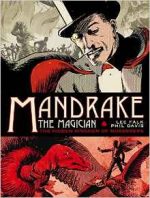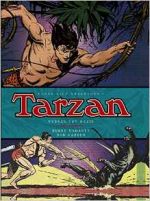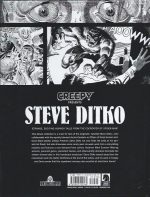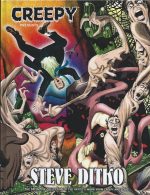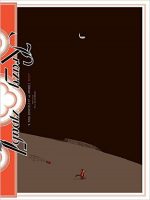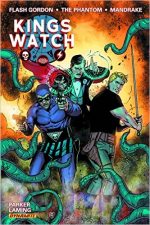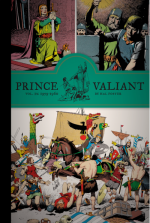
By Hal Foster (Fantagraphics Books)
ISBN: 978-1-60699-876-2
Prince Valiant in the Days of King Arthur premiered on Sunday February 13th 1937: a fabulous full-colour weekly peek into a world where history met myth to produce something greater than both. Creator Hal Foster had developed the feature after leaving a groundbreaking and astoundingly popular run on the Tarzan of the Apes strip he had pioneered.
Prince Valiant offered action, adventure, exoticism, romance and a surprisingly high quota of laughs in its engrossing depiction of noble knights and wicked barbarians played out against a glamorised, dramatised Dark Ages backdrop. The weekly-unfolding epic followed the life of a refugee lad driven from his ancestral Scandinavian homeland of Thule who grew up to roam the world, attaining a paramount position amongst the heroes of fabled Camelot.
Foster wove his complex epic romance over many decades, tracing the progress of a feral wild boy who became a paragon of chivalric virtue: knight, warrior, saviour, avenger and ultimately family patriarch through a constant storm of wild, robust and joyously witty wonderment. The restless champion visited many far-flung lands, siring a dynasty of equally puissant heroes, thereby enchanting generations of readers and thousands of creative types in all the arts.
The strip spawned films, an animated series and all manner of toys, games, books and collections. Prince Valiant was – and is – one of the few adventure strips to have run continuously from the thunderous 1930s to the present day (more than 4000 episodes and still going strong) – and, even here at the end-times of newspaper strips as an art form, it continues in more than 300 American papers and via the internet.
Foster soloed on the feature until 1971 when John Cullen Murphy (Big Ben Bolt) succeeded him as illustrator whilst the originator remained as writer and designer. That ended in 1980, when he finally retired and Cullen Murphy’s daughter Mairead took over colouring and lettering whilst her brother John assumed the writer’s role.
In 2004 the senior Cullen Murphy also retired, since when the strip has soldiered on under the auspices of other extremely talented artists such as Gary Gianni, Scott Roberts and latterly Thomas Yeates & Mark Schultz.
This latest luxuriously oversized (362 x 264 mm) full-colour hardback re-presents pages spanning January 4th 1959 to 25th December 1960 (individual pages #1143-1246) but before proceeding, clears the palate for adventure with Neal Adams’ erudite, illustration-strewn Introduction ‘Learning to Love Hal Foster’.
At the other end of this titanic tome Brian M. Kane continues to explore the master’s commercial endeavours with a lavish exhibition of stunning colour and monochrome illustrations revealing the rugged outdoors life through ‘Hal Foster’s Advertising Art: Johnson Outboard Motors’, but captivating as they are, the real wonderment is, as ever, the unfolding epic that precedes them…
What Has Gone Before: Having brought Christianity to Thule and repelled an invasion of England by Saxons and Danes, Val was despatched by Arthur Pendragon to Cornwall to root out treacherous local kings. Helping true love find its natural course, Valiant acquired a canny new squire in the form of homely yet brilliant Alfred of Lydney. The Prince cleared up the Cornish conspiracy – almost at the cost of his sacrosanct honour – and returned to Camelot after making the acquaintance of the most beautiful horse in the world…
Possessing the red stallion almost caused another war with the Northmen, after which Val returned to his Scandinavian homeland of Thule to reconnect with his family once more.
The reunion was brief, joyous and bittersweet, as the absent father saw how much his children had grown and realised the painful cost of a life of duty. He bid son Arn farewell as the lad was shipped off to enter the household of regal ally King Hap-Atla even as that ruler’s heir became foster-son and page to Valiant’s sire King Aguar.
Peaceful days were few and when a regal summons came from Camelot, the family again took ship. This time the call was for dutiful wife Aleta who blithely entered a hornets’ nest when aging Queen Guinevere was gravely offended by the young beauty’s popularity with the Courtiers and plotted to win an imagined war of favourites…
Valiant was elsewhere employed, leading Arthur’s armies against Danes and Saxons occupying Kent and Sussex. With war brewing again, Val sidelined aging Alfred in favour of young, vigorous and keen martial assistants Edwin and Claudius – a kind act he would later regret, as he did his brief and costly sojourn in the thieves’ paradise called London…
Back in Camelot, a war of wills and clash of personalities between Queens Guinevere and Aleta was settled by most remarkable means, but Valiant still found little time for rest. His beloved friend Gawain had vanished and the trail led straight into the wilds of unruly Wales…
Employing Welsh knight Sir Ian Waldoc as guide and following an unearthly vision provided by largely-vanished mage Merlin, Valiant went westwards disguised as a troubadour, eventually fetching up at the forbidding castle of terrible King Oswick and his five beautiful daughters…
This twelfth knight’s collation resumes as jongleur Cid ingratiates himself at Oswick’s court, offsetting suspicions by feigning a paralysing love for strong liquor whilst scouting out the location of the captive Gawain.
Valiant finds his old comrade pent in a high tower at the very top of the castle, and forms a most dangerous and ingenious scheme involving guile, subterfuge, split-second timing, daredevil acrobatics and the elder chevaliers’s uncanny knack of enchanting women…
With Gawain free once more, the old pals and friendly rivals opt to compete in the Hamlin Garde tournament, but before they can even begin, Val falls foul of a sadistic noble named Coth whose bruised pride leads him to attempt murder most foul through vile assassins.
The monster also has intentions upon heiress Lady Alice of Hamlin, but has not noticed how much Val resembles that noble maid’s preferred suitor Kerwin…
As the tourney plays out many men fall – Coth’s hired killers less noticeably than most – and the villain’s plans to destroy Kerwin fail once Val replaces the young suitor in mortal combat against the murderous malefactor…
With justice triumphant and true love secured, Gawain and Valiant spend calm but provender-poor days roaming the vast Salisbury Plain, and the younger man revels in teaching his civilised elder the tricks peasants use to feed themselves: tactics learned whilst the Prince was a boy growing up in coastal marshes. Unimpressed, Gawain instead cajoles their way into the retinue of a Great Lady’s passing baggage-train and thus embroils them in another saga of thwarted romance…
Impoverished Count Rathford has been forced to betroth his daughter Joan to Hume, heir to the House of Amesbridge to save his estate and dependent vassals. His headstrong child, however, has fallen in love with a lowly squire and plans to elope with him. When the “peasant’s†true station is revealed, however, rather than joy, Joan erupts in incandescent fury at being gulled and events take an even stranger turn after the estranged lovers both fall under Gawain’s reluctant care: the boy as his new squire and she as a far-from-devoted chattel…
Joan’s ever-increasing ire is only expended when the strange party reaches Camelot and artful Queen Aleta takes Joan under her wing…
Happy to avoid further domestic contention of any sort, Valiant undertakes a commission from King Arthur to wipe out a nest of outlaws plaguing the lands of the Earl of Lithway. Accompanied by former bandit-turned-forester Hugh the Fox, the canny Prince makes his way to the beleaguered demesne only to discover the situation is not what has been reported.
The Earl claims his tithes to Arthur were stolen by the errant woodsmen, but the men in the forest tell a different story: one of tyranny, torture, dispossession and oppression…
Acutely aware of evil when he sees it, Val determines to set the situation aright and see justice and order return to Lithway…
With Aleta increasingly aggrieved at Valiant’s wanderlust and neglect, tensions boil over in the apartments of the Prince of Thule, but it is not enough to stop her husband again heading out on a Royal Quest: perhaps the most crucial in Camelot’s troubled history…
In recent years the Knights of the Round Table have become obsessed with the search for the Holy Grail. Now Arthur, seeing his best and bravest constantly lost or maimed in search of it, charges Valiant with proving once and for all whether the story of the sacred cup is fact or myth…
The search takes Val the length and breadth of the nation, consulting wise men and wizards and eventually brings him to the Mendip hills in search of an island called Avalon. En route he exposes a cave troll as a broken-limbed victim of man’s cruelty and learns the poor soul once lived in Avalon, a marshy island housing three hills, Wearyall, the Great Tor and Glastonbury…
Guided there by grateful, maimed Och, Valiant finds a Papal mission from Rome building a cathedral, and learns from a lay brother the official story of the Grail, but before he can question further the encampment is attacked by cruel raider chieftain Timmera the Terrible…
Barely fighting off the marauder’s forces, the clerics immediately begin repairing the damage caused to their holy project, but Valiant resolves to help them by ending the predator threat forever. In this he is aided by Och, who was once the raider’s body-slave…
With the stunted man’s inside information, Val easily infiltrates Timmera’s fortress and brings down the monster’s army from within. On returning to Avalon, Valiant finds an old acquaintance from Ireland in charge of the reconstruction. The man now known as St. Patrick is happy to tell all he knows about the Holy Grail and the questor at last realises what he must tell Arthur…
Heading back, the warrior liberates a captive castle and finds time to play a splendid prank upon Gawain, but upon conferring with Arthur immediately sets off again to battle invading Angles and Saxons rather than attempt reconciliation with Aleta…
The war is brief and brutal and almost costs the prince his life. It takes a brush with near death to finally bring him and Aleta together again, and in the weeks that follow it is decided that the family will return to Thule for his recuperation. That period of painful inactivity completed, with son Arn in tow, the entire clan then head for Aleta’s ancestral kingdom in the Misty Isles, with Viking reiver Boltar providing escort to protect against the pirates of the Mediterranean…
Sadly, even in this sunny paradise peril dogs the family as rival ruler Thrasos makes clear his intention to add Aleta’s islands to his growing empire. The new Alexander, however, has never encountered as savvy a strategist as Aleta or canny tacticians like Valiant and Boltar and his dreams of a Mediterranean empire explosively founder against the devious ploys and armed might of the northern warriors, with even the elements conspiring to send Thrasos to the dustbin of history…
To Be Continued…
A mind-blowing panorama of visual passion and precision, Prince Valiant is a tremendous procession of boisterous action, exotic adventure and grand romance; blending epic fantasy with dry wit and broad humour, soap opera melodrama with shatteringly dark violence.
Lush, lavish and captivating lovely, it is an indisputable landmark of comics fiction and something no fan should miss.
© 2015 King Features Syndicate. All other content and properties © 2015 their respective creators or holders. This edition © 2015 Fantagraphics Books. All rights reserved.


